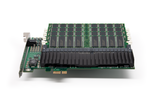Monday, May 4th 2009
DDRdrive LLC Claims 300,000 IOPS with Hybrid PCI-E x1 Solid-State Drive
DDRdrive LLC, another fighter in the SSD market arena, on Monday introduced the DDRdrive X1 - a PCI-Express expansion card featuring a complete solid-state storage system designed for IOPS intensive tasks. The DDRdrive X1 is a PCIe Gen 1-based hybrid SSD, that combines 4 GB of DDR memory and 4 GB of NAND flash memory. Both solid-state technologies work in concert to provide the superior characteristics of DRAM (speed, reliability, and longevity) with the NAND part used for backups. In terms of read/write speeds, the DDRdrive X1 is not that spectacular. Limited by the PCIe x1 interface it can "only" do about 215 MB/s in reads and 155 MB/s in writes. But it's the Input/Output Operations Per Second (IOPS), where X1 really shines. A single drive can hit 300,000+ IOPS Random 512B Reads and 200,000+ IOPS Random 512B Writes. That's a massive bump in operation speed compared to practically all other solid-state drives currently in production. For comparison Fusion IO's enterprise drives are estimated at 200,000 IOPS 512B read, while other consumer SSDs are rated at about 100,000 IOPS 512B read. And those 300,000+ IOPS can be achieved with a maximum power draw of only 9.91 Watts. DDRdrive X1 can also be configured to work in striped (performance) RAID 0, mirrored RAID 1, or RAID 5 regimes.
The DDRdrive X1 is shipping now for $1495 with a 5 year limited warranty. For more information, please be sure to check this page here.
Source:
DDRdrive LLC
The DDRdrive X1 is shipping now for $1495 with a 5 year limited warranty. For more information, please be sure to check this page here.

27 Comments on DDRdrive LLC Claims 300,000 IOPS with Hybrid PCI-E x1 Solid-State Drive
So they want approx 20x the price compared to the Intel Enterprise. That just isnt going to sell. You can RAID an Intel for greater IOPs if you need to. For the same price as this hybrid you can buy 3 Intel X25-E plus a controller, set them up in RAID, get better performance, and have approx 100GB of storage compared to 4GB.
:twitch:
Even the 2 TB WD HDD is cheaper than that!!
However, on another spec. sheet it takes over 60 seconds to load the NAND into volatile, and vice-versa. That is just a TERRIBLE design and shows that somehow performance stats cant be right. How can they have a system that is supposed to be SO FAST yet the bandwidth from NAND to volative is just 4GB/60 sec = just 66MB/sec. A HDD can keep up with those speeds.
Somewhere something doesnt add up with this drive. I'll be avoiding it. No need to spend a fortune on speculation.
Appalling.
The design should be as good as an Intel enterprise SSD, with the option to add sticks of volatile "cache".
i havent found a killer application scenario yet where the same could be achieved for much less :(
However for a business that has a smaller database, as W1zz points out, $1500 is less than a whole new server setup. However the whitesheets are not onthe site that I found. So I could make a grah and spew out numbers too.
Like, seriously, the i-RAM has been out forever.
What this company should have done:
Longer PCI-E 4/8x card (think like big video card long), and shove like.... 16 DDR2 SODIMM slots on the sucker and let it use 32/64GB RAM... then have a 32GB SSD on it or something.
e.g. So you have a 4GB system, all slots full. Want to add another 8GB? Drop in a SODIMM board and fill with 4x cheap SODIMMs. OK, it's not as fast as regular DDR2 on the FSB. But its a lot faster than HDD or SSD virtual memory.
Anyway, nice review here: www.pcper.com/article.php?aid=704&type=expert&pid=1
The DDRdrive X1 was singularly designed to target IOPS intensive applications while setting a new standard in performance, power, and price. In other words, a product exclusively targeted for the enterprise market, i.e. not the consumer market.
What's the difference? In a word - IOPS (Input/Output Operations Per Second).
The DDRdrive X1 is the highest performing (300,000+ IOPS), most power efficient (33uW/IOPS) and lowest price (0.005 $/IOPS) internal storage device in existence.
For a significant class of applications (database tables, indices, and transaction logs) that are capacity constrained, we are an extremely potent and unique solution.
www.ddrdrive.com/ddrdrive_bench.pdf
The drive for speed,
Christopher George
Founder/CTO
DDRdrive LLC
www.ddrdrive.com